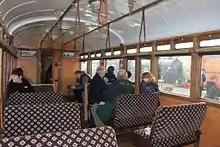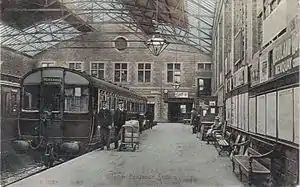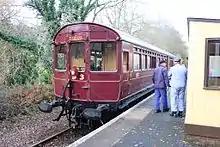GWR steam rail motors
The steam rail motors (SRM) were self-propelled carriages operated by the Great Western Railway in England and Wales from 1903 to 1935. They incorporated a steam locomotive within the body of the carriage.

History

In the first years of the twentieth century, railway managements turned their attention to the need to provide better local passenger services and to reduce costs, in the face of increasing demand for convenient travel and the competitive threat posed by urban tramways.
The original strengths of railways—a fixed track, multiple vehicle passenger trains, highly structured and staffed stations—had limitations in responding to changing needs. The London and South Western Railway had successfully operated a railmotor, consisting of a self-contained passenger vehicle with its own steam power unit, on its Southsea Railway, and the Great Western Railway arranged to borrow one unit for trials on its Golden Valley Line in Gloucestershire. The trial proved successful and a steam rail motor was designed by the Chief Mechanical Engineer George Jackson Churchward. Two units were manufactured, and they entered service on the same route on 12 October 1903. A further 44 were built during 1904 and 1905 and by the time production finished in 1908 the fleet numbered 99 carriage units. There were 112 power units which could be changed between carriages to suit maintenance needs.
On this rural route with a scattered population along the rail corridor, the new vehicles enabled a more frequent service to be operated at lower cost. Stops were made at new locations, and passengers joined and left the train at cheap and simple ground-level platforms using power operated steps on the vehicles. Six new stopping places were provided between Chalford and Gloucester for this service. The guard issued tickets on the train, avoiding the need for staffing at the halts. The vehicles could be driven from either end, so time was not lost in running round at terminals, as would be the case in locomotive hauled trains.
The rail motors were also deployed in cities such as Plymouth, where they operated frequent services calling at new stopping places, competing with the new electric tramways.
The relatively limited accommodation led to problems at busy periods, and driving trailers were constructed with a mechanical facility to control the main unit, so that the train could be driven from the driving trailer, maintaining the avoidance of running round at terminals. However the available power in the small steam engine was a limitation, especially on routes with steep gradients. Maggs records that on the Wrington Vale Light Railway it was frequently necessary for the rail motor to stop on the 1 in 50 gradient to raise enough steam to continue.[1]
Steam engines need frequent servicing, and while this was being undertaken the coach unit was not available for use; steam engine maintenance is also exceptionally dirty, and keeping the passenger sections in an acceptable state of cleanliness was an issue.
Most rail motors were converted into driving trailers for push-and-pull trains (sometimes referred to as autocoaches) serving a separate steam locomotive, and the original power units were scrapped. Autotrains offered many of the benefits of rail motors but, because they were operated by separate locomotives, were much more flexible in operation and easier to maintain. The first of the original rail motors was withdrawn in 1914 but sixty-five survived until 1922. Three of the units were then sold to the London and Blackwall Railway[2] and the last was withdrawn in 1935.
Rail motors nos 42 and 49, along with ex-Port Talbot Railway no 1 (which had been acquired by the GWR in 1908) were sold to the Port of London Authority.
Fleet


All of the fleet were built with four-wheel vertical-boiler power units and a four-wheel trailing bogie under the carriage. Driving wheels were from 3 ft 5 in (1,041 mm) to 4 ft 0 in (1,219 mm); cylinders were from 9 in × 15 in (229 mm × 381 mm) to 12 in × 16 in (305 mm × 406 mm).
Some dimensions were 3⁄4 inch (19 mm) larger than shown in this table where figures have been rounded down to nearest one inch (25 mm).[3]
| Diagram(s) | Quantity | Numbers | Completed | Length | Width |
|---|---|---|---|---|---|
| A, A1 | 2 | 1-2 | 1903 | 57 feet (17.4 m) | 8.5 feet (2.59 m) |
| B, C, D | 12 | 3-14 | 1904 | 59.5 feet (18.1 m) | 8.5 feet (2.59 m) |
| E | 2 | 15-16 | 1905 | 56 feet (17.1 m) | 9 feet (2.74 m) |
| F, G, G1 | 12 | 17-28 | 1904 | 59.5 feet (18.1 m) | 8.5 feet (2.59 m) |
| H, J, J1 | 8 | 29-36 | 1905 | 59.5 feet (18.1 m) | 9 feet (2.74 m) |
| K, K1 | 4 | 37-40 | 1905 | 70 feet (21.3 m) | 9 feet (2.74 m) |
| L | 2 | 41-42 | 1905 | 59.5 feet (18.1 m) | 9 feet (2.74 m) |
| M, M1, N | 10 | 43-52 | 1905 | 70 feet (21.3 m) | 9 feet (2.74 m) |
| O | 18 | 53-58, 61-72 | 1906 | 70 feet (21.3 m) | 9 feet (2.74 m) |
| P | 2 | 59-60 | 1905 | 70 feet (21.3 m) | 9 feet (2.74 m) |
| Q | 8 | 73-80 | 1906 | 70 feet (21.3 m) | 9 feet (2.74 m) |
| Q1 | 3 | 81-83 | 1907 | 59.5 feet (18.1 m) | 9 feet (2.74 m) |
| R | 16 | 84-99 | 1908 | 70 feet (21.3 m) | 9 feet (2.74 m) |
The first sixteen rail motors did not provide luggage space and were designated "suburban", but from No. 17 on, a small luggage compartment was added. The later rail motors were designated "branch".[4]:29
Most of the rail motors were built at Swindon railway works, but 14 (GWR Nos. 15, 16, and 61–72) were built by Kerr Stuart, and 8 (GWR Nos. 73–80) were built by the Gloucester Railway Carriage and Wagon Company (GRC&W).[4]:30 The GRC&W were primarily carriage builders and seem to have contracted out the construction of the engine to another Gloucester firm, Summers and Scott.[4]:31 Kerr Stuart later sold an engine for a similar rail motor to Victorian Railways in Australia.[5]
Number 93

In February 1908 a steam rail motor was turned out from Swindon railway works and given the number 93. It was one of sixteen built to Diagram R, the last batch of steam rail motors. These were 70 feet (21 m) long and 9 feet (2.7 m) wide. After running 479,006 miles (770,885 km) it was withdrawn in November 1934, the power unit was removed and the carriage portion converted into an auto trailer. Now renumbered 212, it operated in this form until May 1956. It was then put into use as a "Work Study Coach" and later as a static office in Birmingham.[6]
In 1970 it was sold to the Great Western Society and moved to their base at Didcot Railway Centre[6] but it was not until 1998 that they were able to make a start on returning it to original condition as a steam rail motor. The frame of the new power bogie was erected in November 2000 at the Tyseley Locomotive Works and was then mounted on wheels and fitted with a boiler. In March 2008 the power bogie was put on display at Didcot. In January 2009 it was moved to the Llangollen Railway where the carriage portion was restored and the two portions brought together.[7] Work was completed in March 2011[8] and No. 93 returned to public service at Didcot in May later that year.[9]
In June 2012 No. 93 was approved for main line operation, even though the re-introduction of wooden bodied vehicles had not been allowed for many years, and was subject to restrictions to reduce the possibility of collisions and any subsequent damage.[10] Since then No. 93 has run on various railways including the Bodmin and Wenford, the South Devon, and the Looe branch (Network Rail).[11][12]
In 2013 the restoration of auto trailer No. 92 was completed at Llangollen (as part of the same project). The railmotor and trailer ran together for the first time in preservation later in the year.[13]
See also
References
- Maggs, Colin G (2004). The Wrington Vale Light Railway. The Oakwood Press. ISBN 0-85361-620-5.
- "Docklands Light Railway—Journey Through History West India Quay to island Gardens" (PDF). Docklands Light Railway. Retrieved 25 August 2019.
- Harris, Michael (1966). Great Western Coaches From 1890. Newton Abbot: David and Charles. pp. 145–147. ISBN 0-7153-8050-8.
- Tutton, Ralph (1993). "The Steam Rail Motors built by the Gloucester Railway Carriage and Wagon Company for the Great Western Railway" (PDF). Gloucestershire Society for Industrial Archaeology Journal for 1993. Retrieved 11 February 2015.
- "STEAM MOTOR-CAR". Melbourne, Victoria: The Argus. 26 November 1912. Retrieved 11 February 2015.
- Steam Railmotor Project. "Railmotor No. 93". Didcot Railway Centre. Retrieved 28 January 2015.
- Steam Railmotor Project. "The New Power Bogie". Didcot Railway Centre. Retrieved 28 January 2015.
- Jones, Robin (May 2011). "By Coelacanth to Carrog". Heritage Railway. No. 149. p. 23.
- Jones, Robin (2 June 2011). "Steam railmotor officially launched into traffic". Heritage Railway. Archived from the original on 7 February 2015. Retrieved 5 February 2015.
- "Vintage Great Western Railway Steam Railmotor approved for main line running". rail.co.uk. 13 July 2012. Retrieved 5 February 2015.
- "Somerset Branch Line Day: Railmotor History?". West Somerset Railway. 5 February 2013. Retrieved 5 February 2015.
- Thomas, Cliff (12 November 2012). "Railmotor makes main line debut". The Railway Magazine. Mortons Media Group. Archived from the original on 5 February 2015. Retrieved 5 February 2015.
- Steam Railmotor Project (2013). "Latest News". Didcot Railway Centre. Retrieved 11 February 2015.
Further reading
- Casserley, HC; Johnston, SW (1966). Locomotives at the Grouping, Volume 4 Great Western Railway. Shepperton: Ian Allan Ltd. ISBN 0-7110-0555-9.
- Davies, F.K. (May 1956) [1952]. The Rail Motor Vehicles (etc.). The Locomotives of the Great Western Railway. Part 11. Railway Correspondence and Travel Society. pp. L4–L11. ISBN 0-901115-38-X.
- Davies, F.K. (May 1974). A Chronological and Statistical Survey. The Locomotives of the Great Western Railway. Part 12. RCTS. pp. M120, M124–M125, M127–M128.
- Davies, F.K.; White, D.E. (December 1983). Preservation and Supplementary Information. The Locomotives of the Great Western Railway. Part 13. RCTS. pp. N16–N18, N35. ISBN 0-901115-60-6.
- Davies, Ken (April 1993). Names and their Origins; Railmotor Services (etc.). The Locomotives of the Great Western Railway. Part 14. RCTS. pp. P30–P36, P75, P82–P84. ISBN 0-901115-75-4.
- Lewis, John (2004). Great Western Steam Railmotors: and their services. Wild Swan Publications Ltd. ISBN 1-874103-96-8.
- Parkhouse, Niel; Pope, Ian. "The Rise and Fall of the Steam Rail Motor". Archive. Lightmoor Press (3): 39–46. ISSN 1352-7991.
External links
| Wikimedia Commons has media related to GWR steam rail motors. |